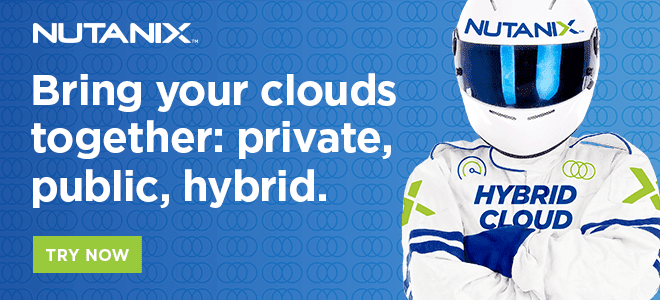The mantle of “invisible IT infrastructure” passed to incoming Nutanix President and CEO Rajiv Ramaswami as the company co-founder Dheeraj Pandey retired in December 2020 after more than 11 years leading the enterprise cloud company. Before leaving, Pandey invited Ramaswami to record a podcast discussion about what it will take to help customers across different industries thrive in a hybrid and multicloud computing future.
For Pandey, Nutanix’s near-term mission is to deliver business value to enterprises that are in various phases of cloud computing. These range from early adopters already embracing hybrid and multicloud environments to laggards only now eyeing the opportunities that a public cloud infrastructure service or a private cloud might afford.
Pandey sees the cloud as a platform for commerce that’s growing as evidenced by enterprises expanding their IT facilities from datacenters to edge computing and public cloud infrastructure services.
Ramaswami agreed. “Our charter is to make doing that seamlessly and allow them to run a consistent stack wherever they are running their workloads,” he said.
Enterprises should be able to move those workloads, the execs agreed, to the optimum cloud platform at any given time.
“It’s all about choice and ubiquity,” said Pandey. “That’s probably the big test for us in the coming three to five years.”
Pandey, steeped in the many lessons that can be learned from the tech industry evolution, said that Microsoft was about Windows and the apps. Apple was about iOS and the apps. Then he asked Ramaswami about this apparent duality and its impact on the success of platform companies like Nutanix.
Ramaswami replied that a platform provides a set of foundational capabilities upon which customers can run essential applications and workloads.
“And you can also have an ecosystem of other providers who can build off your platform and deliver additional value-added services to the customer,” he said.
What new workloads can we attract to our platform? Ramaswami asked.
“I think that's the opportunity for companies like us,” he answered. “We need to really help customers figure out where and how to run their workloads better.”
Then Ramaswami talked about new workloads, including artificial intelligence and machine-learning-based applications, as components that are becoming essential for almost any full ecosystem of services.
“A platform needs to have extensibility,” he said. “It needs to have APIs and we need to be able to support a range of third-party providers who can build off and enhance it.”
As an example, he pointed to the Nutanix Mine appliance, a data protection and management solution. The data backup, restore and long-term retention offering integrates with third-party backup solutions such as those from partners HYCU and Veeam.
Evolving Business and Cloud Consumption Models
Pandey traced the general evolution of IT operating models from hardware to software then subscription to consumption.
“Your career has mimicked how this industry has transformed,” Pandey said before challenging Ramaswami to look ahead to the culmination of the on- and off-prem duality.
“There are two things we have to look at here,” said Ramaswami. First, he said, is where businesses can run apps and where they’ll run best. The other is how customers consume those resources. It is essential to focus on these.
“You can buy a perpetual license,” he said. “You can buy it in an appliance model. You can buy software that's delivered to you by subscription. And finally, you can also get software that's delivered to you as a service.”
“Now, at the end of the day, we want to do what makes sense for the customer to consume.”
Flexibility in software consumption is the name of the game, which Ramaswami said is why many businesses are moving from perpetual licensing to a subscription model.
“It gives them a lot more flexibility,” he said. “Now, that's the journey that we all need to embrace because ultimately it's what our customers want.”
He added that such transitions impact how a company builds products and solutions, how it takes them to market and how it builds back-office fulfillment systems.
“Customer success becomes very critical for us because that's what leads to expansion and leads to renewals over time,” Ramaswami said. “Our success inevitably gets tied to customers being successful. And that's the beauty of this overall cloud [subscription] model.”
Helping Customers Avoid Vendor Lock-In
Pandey built Nutanix into a $1.2 billion, 6,000-employee company over a period of a decade based largely on the concept of openness and extensibility. He said almost half of Nutanix deployments currently run on another company’s hypervisor. The other half run on Nutanix’s AHV hypervisor.
“But it was nothing like that five years ago,” said Pandey, showing the importance of offering customers choice instead of locking them into or out of working with leading tech providers.
Ramaswami agreed and emphasized that Nutanix must continue to provide customer flexibility and choice and not force customers into any kind of lock-in.
“Our innovation has to be tied to creating business value for customers,” he said. “At the same time, we have to innovate within a context of what the customers can actually consume and make use of.”
He also mentioned interoperability with container technologies such as Kubernetes orchestration software as “very important workloads” to run on top of our platform.
“The same holds true for all the other ecosystem providers, whether it be security, networking or something else,” Ramaswami said. “Fundamentally we have to fit into the ecosystem and deliver unique value.”
Post-Pandemic Musings
The two leaders reflected on the COVID-19 pandemic and how it has affected business, daily lives and careers of the modern workforce. Pandey said he felt the pandemic had taught many a lot about what really matters in life, as workforces continue to navigate blending work and personal time into experiences throughout the workday and workweek.
As a result, Pandey pointed out, the “hybrid” theme applies not just to cloud computing and Nutanix’s business.
“You know, we're living in a world of hybrid cloud, hybrid computing and hybrid lives,” he said.
Ramaswami said he feels that even as vaccines become distributed and the world opens up again.
“I don't think we're going back to the way it was before,” he said. “I think the world is going to be much more distributed, from a workforce perspective. It allows us the flexibility to work in a much more distributed manner, which means we can get talent wherever it’s available, as opposed to forcing talent to relocate where the company is.”
Ramaswami acknowledged that a remote workforce challenges employers to improve their ability to engage with people who are distributed. He said a lot of norms have changed
“We've started getting better at how we do that,” he said. “We need to make sure everybody has tools to make themselves productive. And we need to interact and engage with people and continue to build social capital. So this pandemic has created a massive transformation in terms of how we think about work and life, and it's here to stay.”
Joanie Wexler is a contributing writer and editor with more than 20 years’ experience covering the business implications of IT and computer networking technologies.
Podcast produced by Jason Lopez, executive producer of Tech Barometer, the podcast outlet for The Forecast. He’s the founder of Connected Social Media. Previously, he was executive producer at PodTech and a reporter at NPR.
© 2021 Nutanix, Inc. All rights reserved. For additional legal information, please go here.







